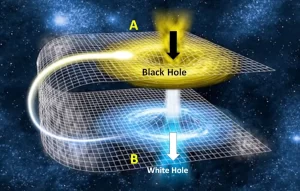Reversing the Cosmic Narrative | From Black Holes to White Holes | Exploring Carlo Rovelli’s Dazzling Vision of a Universe Where Time Bends and Matter Transcends

Carlo Rovelli’s latest book, as reviewed in The Guardian, takes readers on a breathtaking journey to the heart of a black hole—only to emerge on the other side as a white hole. Rovelli’s exploration challenges our classical understanding of space and time, suggesting that the gravitational collapse of stars does not lead to a dead end, but rather to a quantum rebirth. In this audacious narrative, he flips the conventional script, positing that white holes—objects from which matter can only emerge—could be the other side of the cosmic coin, offering a glimpse into the transformative power of quantum mechanics.
At the core of Rovelli’s theory lies the interplay between general relativity and quantum mechanics. Traditionally, black holes are understood as regions where gravity is so strong that nothing, not even light, can escape. However, the same mathematical framework that predicts black holes also allows for the possibility of white holes. These elusive objects, though not yet observed in the cosmos, challenge our perception of time as linear and unidirectional. Instead, they open up a dialogue about a universe where time may loop, reverse, or even bounce back on itself—a revolutionary idea that continues to captivate physicists and enthusiasts alike.
Supplementary insights from astrophysical research reinforce Rovelli’s ideas by highlighting the delicate balance between collapse and expansion at the quantum level. According to recent studies featured on reputable scientific platforms such as NASA and the European Space Agency, when a collapsing star reaches an extreme density, the classical laws of physics give way to quantum uncertainties. This quantum domain, characterized by probabilistic events and non-deterministic outcomes, might allow for a “bounce” effect. In this scenario, the matter within a black hole could reverse its collapse and emerge as a white hole, suggesting that the death of a star is not an ultimate end, but a transformation within the cosmic continuum.
Rovelli’s lyrical style makes complex ideas accessible, even for lay readers. His brief but potent narrative captures the imagination much like the final, enigmatic sequence of 2001: A Space Odyssey—an experience where the destination is unknown, yet the journey itself is filled with wonder. This approach not only democratizes high-level theoretical physics but also reconnects us with the timeless allure of the cosmos, inviting everyone to marvel at the mysteries that lie at the boundaries of human knowledge.
Adding further depth to the discussion, research from platforms such as Scientific American and New Scientist provides additional context. These sources emphasize that the concept of white holes, while speculative, has a firm footing in the equations of physics. They note that such ideas are part of an ongoing effort to reconcile the apparent conflicts between quantum mechanics and general relativity. This reconciliation is central to modern physics, as it promises to unveil a more unified understanding of the universe—one that might ultimately explain phenomena ranging from the origin of the cosmos to the nature of time itself.
The review also highlights the courage required to propose such groundbreaking theories. Rovelli’s willingness to venture into the unknown, despite criticism from some quarters of the scientific community, is emblematic of the adventurous spirit that drives scientific discovery. His work is a reminder that true progress in understanding the universe often demands challenging established narratives. In this sense, his ideas resonate not just as theoretical constructs but as philosophical provocations—prompting us to reconsider the nature of existence and our place within an ever-evolving cosmic dance.
In conclusion, Carlo Rovelli’s vision of white holes as the quantum rebirth of collapsing stars invites us to rethink the boundaries of life, death, and transformation. His work, enriched by the latest astrophysical research, paints a picture of the universe where time is fluid and the end of one cosmic journey is merely the beginning of another. For those who yearn to rediscover the magic of the cosmos and to question the fundamental nature of reality, Rovelli’s ideas offer an exhilarating roadmap—one that is as intellectually rigorous as it is poetically inspiring.
Key Takeaways:
- Cosmic Rebirth: The transformation from black holes to white holes challenges our conventional understanding of stellar death, suggesting that every end might be a new beginning.
- Time’s Fluidity: Rovelli’s theories invite us to see time not as a linear progression but as a dynamic, reversible dimension influenced by quantum phenomena.
- Unified Universe: The interplay between general relativity and quantum mechanics points toward a unified framework that could revolutionize our understanding of the cosmos.
“In fewer pages than it would take some authors to describe how they would prepare an omelette, Rovelli drags you into the heart of a black hole and then – somehow – out the other side.”
Join us at SpeciesUniverse.com to delve deeper into these transformative ideas. Engage with our community, share your insights, and explore more content that challenges the boundaries of science and philosophy as we journey together into the heart of the universe.
More details: here

Leave a Reply